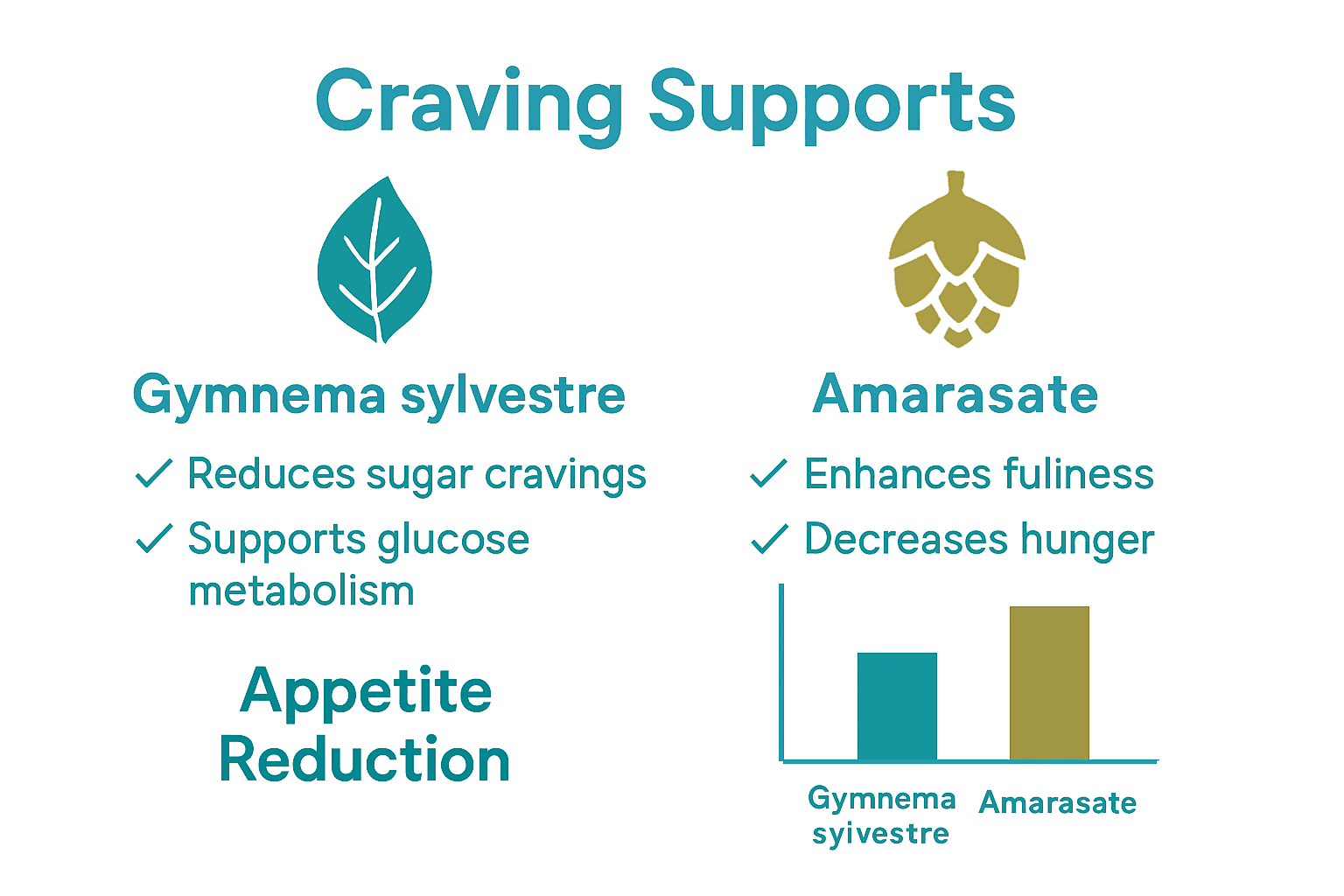

Natural Ways to Reduce Cravings Naturally in 2025
More than 90 percent of people battling cravings report that stress, boredom, or social situations often trigger their urges to snack. For anyone trying to build healthier habits, these unseen triggers can make progress nearly impossible. When you learn to spot your personal patterns, you unlock powerful tools for long-term change. This guide breaks down proven techniques to help you pinpoint your cravings, swap out unhealthy routines, and gain real control over your wellness journey.
Table of Contents
- Step 1: Identify Your Main Triggers For Cravings
- Step 2: Replace Unhealthy Rituals With Herbal Alternatives
- Step 3: Incorporate Mindful Breathing And Relaxation Techniques
- Step 4: Select Natural Supplements And Herbal Support
- Step 5: Monitor Your Progress And Adjust Strategies
Quick Summary
| Key Point | Explanation |
|---|---|
| 1. Identify your craving triggers | Keep a detailed journal of cravings to understand their context, including emotional and environmental factors. |
| 2. Replace unhealthy habits with herbal alternatives | Swap out stress-induced snacks for calming herbal teas or natural supplements to reduce cravings. |
| 3. Practice mindful breathing techniques | Use deep breathing exercises like the 4-7-8 method to manage stress and craving intensity effectively. |
| 4. Monitor your progress systematically | Track cravings and emotional responses in a food diary to identify patterns and adjust strategies. |
| 5. Create a ritual replacement toolkit | Prepare a box with herbal alternatives and calming items to facilitate healthy habit changes and support your journey. |
Step 1: Identify Your Main Triggers for Cravings
Understanding your personal craving triggers is the key to developing effective management strategies. According to Heart.org, food cravings are often sparked by specific sensory and emotional experiences that can derail your wellness goals.
To systematically identify your triggers, start by keeping a detailed journal documenting when cravings occur. Note the context surrounding each craving: What were you doing? What emotions were you experiencing? Were there specific environmental cues like smells, sights, or social situations? Hopkins Medicine emphasizes that triggers can be both external (advertisements, social media) and internal (stress, emotional states).
A powerful technique is to create a trigger map showing patterns. For instance, you might discover you crave certain foods when feeling stressed at work or when watching late night television. By recognizing these patterns, you can proactively develop alternative coping mechanisms. The goal is not elimination but understanding and strategic management of your unique craving landscape.
Quick Pro Tip: Take photos of your food environment when cravings hit. Visual documentation can reveal surprising triggers you might otherwise overlook. This method transforms passive observation into an active strategy for wellness.
In the next step, we will explore practical techniques for interrupting and redirecting these identified triggers.
Step 2: Replace Unhealthy Rituals with Herbal Alternatives
Replacing unhealthy habits with natural alternatives can transform your wellness journey and reduce cravings effectively. For example, Wikipedia highlights Gymnema sylvestre, an Ayurvedic plant with remarkable properties that can help suppress sweet cravings by interacting with taste receptors.
Start by identifying your specific trigger rituals and consciously swap them with healthier herbal alternatives. If you typically reach for sugary snacks when stressed, consider herbal teas or natural supplements that provide a similar sensory experience. Some people find success with natural nicotine replacements that offer a soothing ritual without harmful chemicals.
Interestingly, research suggests that certain herbal extracts can physiologically reduce cravings. Wikipedia notes that Amarasate, a bitter hop extract, can trigger a ‘Bitter Brake’ satiety mechanism that significantly reduces hunger and cravings in clinical trials.
Quick Pro Tip: Create a ritual replacement box filled with herbal alternatives like calming teas, CBD smokes, or natural chewables. This tangible toolkit makes transitioning away from unhealthy habits more structured and intentional.

In the next step, we will explore mindfulness techniques that complement these herbal strategies for comprehensive craving management.
Step 3: Incorporate Mindful Breathing and Relaxation Techniques
Controlling cravings starts with mastering your body’s stress response through intentional breathing and relaxation techniques. Allina Health emphasizes that deep breathing exercises can be a powerful tool for managing emotional triggers that often lead to unhealthy food cravings.
Begin with a simple 4-7-8 breathing technique. Inhale deeply through your nose for 4 seconds, hold the breath for 7 seconds, then exhale slowly through your mouth for 8 seconds. This method activates your parasympathetic nervous system, reducing stress and diminishing the intensity of cravings. Johns Hopkins Medicine recommends practicing mindful eating alongside these breathing exercises by paying close attention to hunger cues and eating without distractions.
Consider integrating CBD relaxation techniques to enhance your stress management strategy. By combining deep breathing with natural wellness practices, you create a holistic approach to craving control that addresses both physiological and emotional components.
Quick Pro Tip: Create a dedicated 5-minute daily breathing ritual. Set a specific time each day to practice these techniques, transforming them from occasional interventions into a consistent wellness practice.
In the next step, we will explore how to build long term resilience against cravings through strategic lifestyle adjustments.
Step 4: Select Natural Supplements and Herbal Support
Navigating the world of natural supplements requires strategic selection to effectively manage and reduce cravings. Wikipedia highlights Gymnema sylvestre as a powerful Ayurvedic herb that contains gymnemic acids capable of interacting with taste receptors to suppress sweet cravings.
Consider exploring a range of herbal supplements that target different craving mechanisms. For instance, Wikipedia notes Amarasate as a promising hop extract that triggers the ‘Bitter Brake’ satiety mechanism, demonstrating significant reductions in hunger during clinical trials. When selecting supplements, prioritize quality sourcing and consult with healthcare professionals to ensure compatibility with your individual wellness goals.
Integrating natural wellness routines can enhance the effectiveness of herbal supplements. Look for organic, third-party tested products that provide transparent ingredient profiles and potential benefits.
Quick Pro Tip: Start with small doses of herbal supplements and monitor your body’s response. Keep a journal to track changes in craving intensity and overall wellness.

In the next step, we will explore how to create a sustainable support system that reinforces your craving management strategies.
Step 5: Monitor Your Progress and Adjust Strategies
Johns Hopkins Medicine recommends keeping a detailed food diary as a powerful tool for tracking your progress in managing cravings. This systematic approach allows you to observe patterns, triggers, and your body’s responses to different strategies you have implemented.
Allina Health emphasizes the importance of recognizing habit loops and automatic thoughts that reinforce cravings. Develop a tracking system that goes beyond just food intake to include emotional states, stress levels, sleep quality, and environmental factors that might influence your craving intensity.
Consider using natural wellness routines as a framework for consistent monitoring. Create a weekly review process where you analyze your progress, celebrate small victories, and identify areas that need adjustment.
Quick Pro Tip: Use a digital or physical journal with color coded sections to make tracking more engaging. Green for successful days, yellow for challenging moments, and red for setbacks that require strategic intervention.
In the final step, we will discuss how to maintain long term success and build resilience in your wellness journey.
Discover Natural Solutions to Manage Your Cravings Effectively
The challenge of reducing cravings naturally requires a blend of mindful strategies and healthy alternatives. This article highlighted how personal triggers, herbal supports like Gymnema sylvestre, and relaxation techniques can reshape your cravings landscape. If you want to replace unhealthy rituals with soothing, natural options, Full Moons Club offers a premium line of CBD smokes and hemp cigarettes made from organic U.S.-grown hemp that support stress relief and mindful moments.

Take control of your craving patterns today with our tobacco-free and nicotine-free herbal alternatives. Each product is crafted to help you create peaceful rituals that align with your wellness goals. Visit Full Moons Club and explore the benefits of a chemical-free, sustainable smoking experience. Don’t wait to embrace a healthier lifestyle supported by nature and science. Start your journey now by exploring our selection at Full Moons Club and learn how natural solutions can make cravings easier to manage.
Frequently Asked Questions
How can I identify my triggers for food cravings?
Start by keeping a detailed journal to document when cravings occur, noting the associated activities, emotions, and environmental cues. Analyze this information to recognize patterns over time, which can help you understand what specifically triggers your cravings.
What are some herbal alternatives to unhealthy snacks for craving management?
Consider replacing sugary snacks with herbal options like calming teas or natural supplements. For instance, if stress triggers sweet cravings, herbal teas can provide a similar sensory experience without the added sugars.
What breathing techniques can help reduce cravings?
Practice the 4-7-8 breathing technique, where you inhale for 4 seconds, hold for 7 seconds, and exhale for 8 seconds. This exercise can calm your nervous system and reduce the intensity of cravings when done consistently.
How can I monitor my progress in managing cravings effectively?
Keep a food diary that tracks not just your food intake but also emotional states and other triggers. Regularly review this journal to identify patterns and areas needing adjustment, which can help you stay on track in reducing cravings over time.
What role do natural supplements play in reducing cravings?
Natural supplements, like Gymnema sylvestre or Amarasate, can help suppress cravings by interacting with your taste receptors or satiety signals. Start with small doses and monitor your body’s response to determine effectiveness in your craving management strategy.

